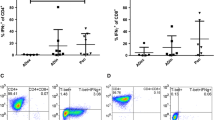Summary
Forty-one persons were tested for tuberculin skin reactivity. Epidermal cells (ECs) were isolated from the tuberculin reaction and from a contra lateral, non injected skin area. We found a significant increase of epidermal thymocyte activating factor (ETAF) in epidermis overlying a positive tuberculin reaction together with an increase of OKT6 and class II (HLA-DR) positive cells. Allogeneic lymphocytes proliferated significantly more when mixed with ECs from a positive tuberculin skin test. Injection of tuberculin per se or a negative reaction did not induce similar changes. The described model seems useful for functional studies of ECs and lymphocytes in patients with contact dermatitis.
Similar content being viewed by others
References
Baker D, Parker DD, Turk JL (1985) Effect of depletion of epidermal dendritic cells on the induction of contact sensitivity in the guinea pig. Br J Dermatol 113:285–294
Braathen LR, Thorsby E (1980) Studies on human epidermal Langerhans cells. I. Alloactivating and antigen-presenting capacity. Scand J Immunol 11:401–408
Czernielewski J, Faure M, Schmitt D, Thivolet J (1982) In vitro mixed skin cell lymphocyte culture reaction (MSLR) in man: analysis of the epidermal cell and T-cell populations. Clin Exp Immunol 50:426–433
Gahring LC, Buckley A, Daynes RA (1986) Presence of epidermal-derived thymocyte activating factor/interleukin-1 in normal human stratum corneum. J Clin Invest 76:1585–1591
Hauser C, Saurat JH, Schmitt JA, Jaunin F, Dayer JH (1986) Interleukin-1 is present in normal human epidermis. J Immunol 136:3317–3322
Inaba K, Schuler G, Witmer MD, Valinksy J, Atassi B, Steinman RM (1986) Immunologic properties of purified epidermal Langerhans cells. Distinct requirements for stimulation of unprimed and sensitized T lymphocytes. J Exp Med 164:605–613
Kaplan G, Witmer MD, Nath N, Steinman RM et al. (1986) Influence of delayed immune reactions on human epidermal keratinocytes. Proc Natl Acad Sci USA 83:3469–3473
Kragballe K, Ellegaard J, Herlin T (1980) Antibody-dependent monocyte-mediated cytotoxicity. Isolation and identification by esterase-staining of monocytes detached from monolayers by lowering the temperature. Scand J Haematol 24:399–405
Kragballe K, Marcelo CL, Voorhees JJ, Sauder DN (1987) Formation of epidermal cell-derived thymocyte-activating factor (ETAF) from cultured human keratinocytes from normal and uninvolved psoriatic skin. J Invest Dermatol 88:8–10
Kiistala U, Mustakallio KK (1964) In vivo separation of epidermis by production of suction blister. Lancet 1:1444–1445
Lampert IA (1984) Expression of HLA-DR (Ia-like) antigen on epidermal keratinocytes in human dermatoses. Clin Exp Immunol 57:93–101
Luger TA, Stadler BM, Katz SI, Oppenheim JJ (1981) Epidermal cell (keratinocyte) derived thymocyte activating factor (ETAF). J Immunol 127:1493–1498
Luger TA, Stadler BM, Luger BM, Sztein MB, Schmidt JA, Hawley-Nelson P, Grabner G, Oppenheim JJ (1983) Characteristics of an epidermal cell thymocyte-activating factor (ETAF) produced by human epidermal cells and a human squamous cell carcinoma cell line. J Invest Dermatol 81:187–193
Morhenn V, Engleman EG, Farber EM (1978) Quantitation and characterization of the in vitro stimulation of lymphocyte proliferation by epidermal cells. J Invest Dermatol 70:213 (Abstract)
Poulter LW, Seymour GJ, Duke O, Janossy G, Panayi G (1982) Immunological analysis of delayed-type hypersensitivity in man. Cell Immunol 74:358–369
Platt JL, Grant BW, Eddy AA, Michael AF (1983) Immune cell populations in cutaneous delayed-type hypersensitivity. J Exp Med 158:1227–1242
Remvig L, Enk C, Svensson M (1985) A standardized human T-lymphocyte proliferation assay for detecting soluble accessory factors from monocytes. II. Interleukin-1 production and detection. Acta Pathol Microbiol Immunol Scand [C] 93:91–96
Rowden G, Lewis MG, Sullivan AC (1977) Ia antigen on human epidermal Langerhan's cells. Nature 268:247–249
Sahasrabuddhe G, Dinarello C, Martin B, Maizel AL (1985) Intra-cellular human Il-1: a precursor for the secreted monokine. Lymphokine Res 4:25–213
Scheynius A, Tjernlund U (1984) Human keratinocytes express HLA-DR antigens in the tuberculin reaction. Scand J Immunol 19:141–147
Schmitt A, Hauser C, Jaunum F, Dayer JM, Saurat JH (1986) Normal rat epidermis contains high amount of natural tissue Il-1. Lymphokine Res 5:105–117
Schroder JM, Christophers E (1986) Identification of C5a-desarg and an anionic neutrophil-activating peptide (ANAP) in psoriatic scales. J. Invest Dermatol 87:53–58
Silberger I (1973) Apposition of mononuclear cells to Langerhans cells in contact allergic reactions. Acta Derm Venereol (Stockh) 53:1–12
Silberberg I, Baer RL, Rosenthal S (1976) The role of Langerhans cells in allergic contact hypersensitivity: a review of findings in man and guinea pigs. J Invest Dermatol 66:210–217
Stingl G, Katz SI, Shevach EM, Rosenthal AS, Green I (1978) Analogous functions of macrophages and Langerhans cells in the initiation of the immune response. J Invest Dermatol 71:59–64
Takematsu H, Terui T, Ohkohchi K, Tagami H, Suzuki R, Kumagai K (1986) Presence of chemotactic peptides other than C5a anaphylatoxin in scales of psoriasis and sterile pustular dermatoses. Acta Derm Venereol (Stockh) 66:93–97
Takematsu H, Suzuki R, Tagami H, Kumagai K (1986) Interleukin-1-like activity in horny layer extracts: decreased activity in scale extracts of psoriasis and sterile pustular dermatoses. Dermatologica 172:236–240
Ternowitz T, Thestrup-Pedersen K (1986) Epidermis and lymphocyte interactions during a tuberculin skin reaction. II. Epidermis contains specific lymphocyte chemotactic factors. J Invest Dermatol 87:613–617
Unanue ER, Beller DI, Lu CY, Allen PM (1984) Antigen presentation: comments on its regulation and mechanism. J Immunol 132:1–5
Author information
Authors and Affiliations
Rights and permissions
About this article
Cite this article
Larsen, C.G., Ternowitz, T., Larsen, F.G. et al. Epidermis and lymphocyte interactions during a tuberculin skin reaction. Arch Dermatol Res 280, 83–88 (1988). https://doi.org/10.1007/BF00417709
Received:
Issue Date:
DOI: https://doi.org/10.1007/BF00417709




